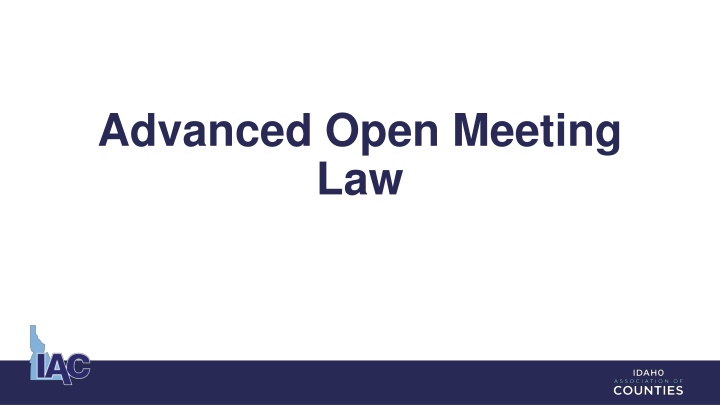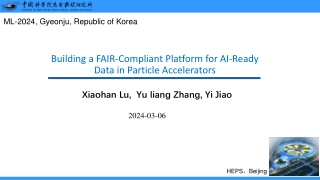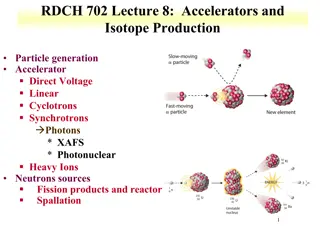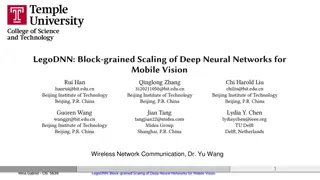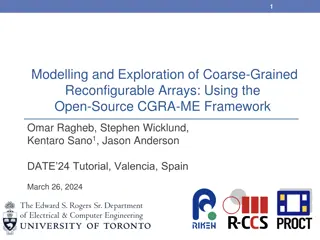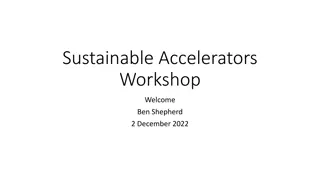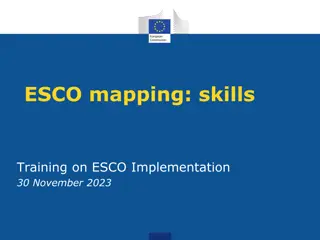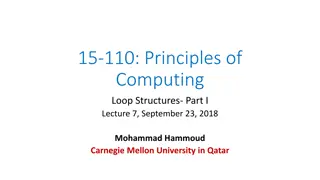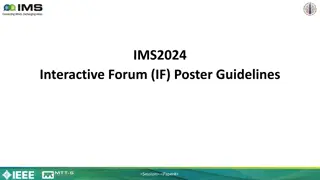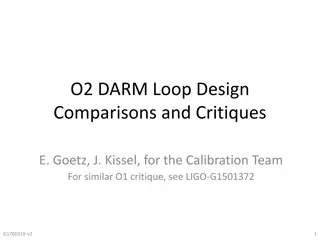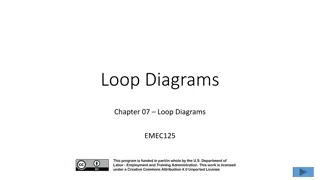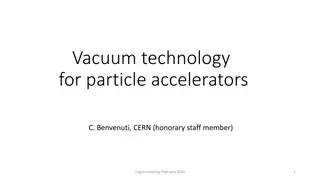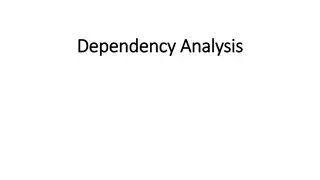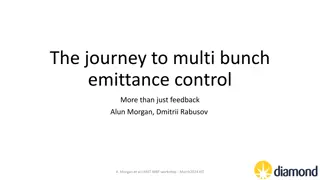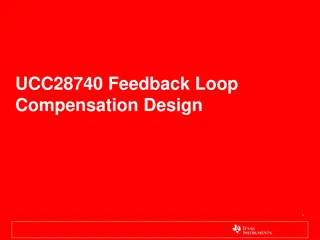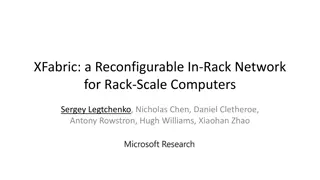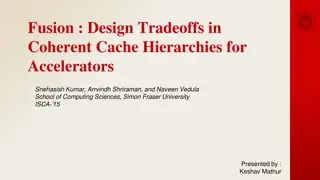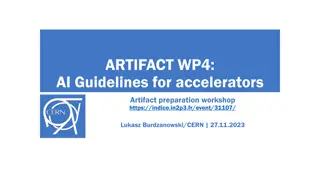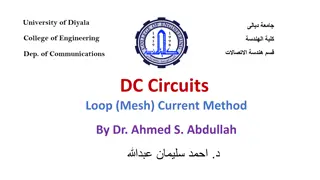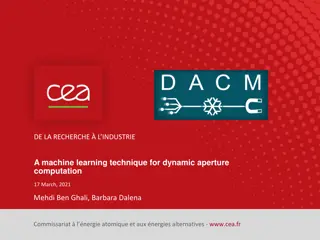Branch-Aware Loop Mapping on Coarse-Grained Reconfigurable Accelerators
Increase performance at lower power by leveraging hardware accelerators and exploring solutions such as coarse-grained reconfigurable accelerators for efficient resource utilization and control flow acceleration. Learn about loop acceleration, predication techniques, dual-issue architecture, and kernel mapping on dual-issue CGRAs.
Download Presentation

Please find below an Image/Link to download the presentation.
The content on the website is provided AS IS for your information and personal use only. It may not be sold, licensed, or shared on other websites without obtaining consent from the author.If you encounter any issues during the download, it is possible that the publisher has removed the file from their server.
You are allowed to download the files provided on this website for personal or commercial use, subject to the condition that they are used lawfully. All files are the property of their respective owners.
The content on the website is provided AS IS for your information and personal use only. It may not be sold, licensed, or shared on other websites without obtaining consent from the author.
E N D
Presentation Transcript
Why Have an Open Meeting Law The people of the state of Idaho in creating the instruments of government that serve them, do not yield their sovereignty to the agencies so created. Therefore, the legislature finds and declares that it is the policy of this state that the formation of public policy is public business and shall not be conducted in secret ( 74-201, Idaho Code).
Who Follows the Open Meeting Law Governing board Statutory county committees and boards Fiar board P&Z commission Others: waterways, snowmobile, airport, historical, etc. Any committee formed by the governing board to make a recommendation to the governing board All boards, advisory boards, and committees created by the governing board are subject to open meeting, public records, and conflicts of interest laws and should be trained and staffed accordingly.
Purpose of Public Meetings Required by law Conduct county business Gather needed (and wanted) input Public meetings are a spectator sport The public gets to watch/listen Public only participates if invited
Purpose of Public Hearings Required by law for specific purposes Budget BOE P&Z Regarding an ordinance Vacating ROW Who are the participants? Specific advertising required?
Public Meeting vs Public Hearing Remember Public hearings: Usually occur at a public meeting May be conducted by a hearing officer Decisions are not made at hearings
Key to Effective Meetings Be organized Be purposeful Be respectful Set and understand expectations Elected officials Staff Public (post rules if you have them)
Role of the Board Chairman 1. Conducts the meeting 2. Encourages fellow commissioners to participate in the meeting 3. Controls public comment when it is allowed 4. Keeps the discussion on agenda topic 5. Prohibits personal attacks
Conducting meetings By laws? 31-820. By-laws. To make and enforce such rules and regulations for the government of their body, the preservation of order and the transaction of business as may be necessary. Roberts rules? Make your own? Do you really need these?
Sample Meeting Rules 1. Each speaker during the public comment period will be limited to five minutes. 2. The board of county commissioners may not hear or take testimony regarding Andy planning and zoning matter that is before the county or is known to likely be before the county. 3. Issues regarding the performance of county employees constitute matters that must be discussed only in executive session And are not appropriate in the public portion of the meeting. 4. Matters that have been previously heard and decided by the board of county commissioners may be ruled out of order for the public comment period.
Conduct at meetings Fellow board members Public at meetings Public at hearings Options Take a break gavel? Explain process in advance. Do you need law enforcement? Rearrange the furniture
Decision Making A valid decision is: Made at a posted meeting with a quorum present On the agenda as an action item Motion made followed by affirmative vote Recorded in official meeting minutes
Decision Making A decision is not: Polling the board Gathering signatures Made at an improperly posted meeting Made without being listed on an agenda as action item Valid if deliberations occurred outside of the meeting
Voting Most issues are decided by a voice vote Some issues require a roll call vote: Decision to enter executive session A governing board member may request a roll call vote for any matter
The Art of Persuasion: Communicating with BOCC Connect before offering your perspective Acknowledge the position of fellow board members Use I statements to build understanding/offer your perspective This is where I stand (include your reasons and cite your data/sources) Avoid truth statements This is just how it is going to be You are wrong Focus on what you can do, not what you won t do or can t do
The Art of Persuasion - Dealing with the Public Establish clear ground rules and empower board chair to enforce them Give one person the floor at a time (don t speak over others or allow others to speak over you) Speak up when the conversation veers off the agenda or into difficult matters Acknowledge strong feelings and then redirect to the agenda item If one person dominates the discussion, call on others to participate Thank you for your input Sally, would it be ok if we hear from Jill and Susan before we hear from you?
The Art of Persuasion - Listening to Others Separate people from problems Obtain facts Understand opposing viewpoints Use a fair process to make decisions Be willing to both persuade and be persuaded (consider your arguments and the arguments made by others, explain your position and be open to the positions of others)
Overcoming Disagreements Differ respectfully, compromise, and focus on what is best for the county. If you do, both county employees and community member will be more likely to follow your lead. If you choose to get mired in blame and division, county employees will follow your example (as will the community). This can grind county operations to a stand still causing the county to fracture.
Learning to Lead Lead in the way your employees and constituents expect you to lead. Help each other focus on the future and the common interests that bind you. Recognize that elected officials have different opinions and that's ok and that's ok. The sign of true leaders is the ability to work through differences in ways that advance the needs of the county, build trust, and create a culture of respect.
Tips CHECK YOUR EGO AT THE DOOR CHECK YOUR EGO AT THE DOOR: Focus on what is best for the county, not yourself. KEEP CALM UNDER PRESSURE KEEP CALM UNDER PRESSURE: Take a deep breath and think about your response when someone (or something) is pushing your buttons.
Remember One Thing No matter what you do, public perception will become your legacy.
Require approval of two-thirds of the board by roll call vote & recorded in the minutes Both the motion to go into executive session and the minutes must state the specific statutory authorization for the executive session Final actions/decisions must be made in public session
Common Reasons for Executive Session I.C. 74-206: Personnel selection and evaluation (a) and (b) Discuss litigation with your attorney (f) Consider claims or potential claims with your risk manager or insurer (i)
Who Attends Executive Session Members of the governing board Anyone invited to attend by the governing board
Staying on Topic Once in executive session, only discuss the topic at hand TIP: set a time limit for the executive session
Meeting Notices, Agendas, and Minutes
Meeting Notices Regular meeting Second Monday or set by ordinance Posted physically On your web site Special or emergency meetings What about today is there public notice? Should there be?
Meeting Agendas An agenda is required for each meeting. Posted same as meeting notice Both must be on web site and action items noted Posted 48 hours (or 24 hours for special meeting) Only good faith amendments For action items - emergency with justification
Structuring the Agenda An agenda includes: Topics to be discussed/decided at the meeting. Topics requiring action must be designated as an action item Check by looking at past minutes. An agenda should be written for those not familiar with your world. Avoid using acronyms.
Agenda Items to Avoid A list of categories Old business, new business, adjourn Who will be speaking Decision requests hidden in reports
Approval of Minutes On the agenda consent agenda? Draft minutes are available to the public. An opportunity for the council to make sure that the minutes accurately reflect actions taken. Not in the minutes didn t happen, actions by signature are usually invalid. Often the Clerk must guess at what you meant, this is a review of that guess.
Curing Violations If a violation - determine within 14 days and acknowledge the violation Then 14 days to void that action or actions Either self-recognition or notice of an alleged violation A cure acts as a bar to the civil penalty
Consequences Actions may be null and void. Members subject to a civil penalty. up to $250 for first time up to $1500 for knowingly participating up to $2500 for second violation within last 12 months
